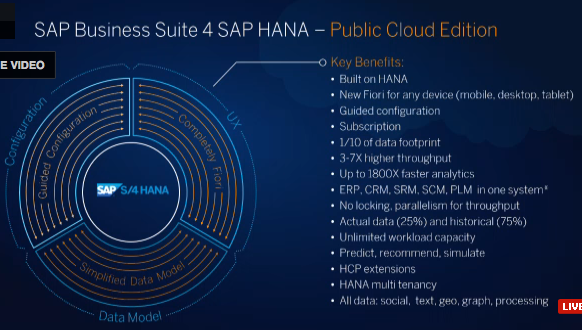Latest SAP HANA Release Targets Cloud Transition

SAP, the enterprise application software and database leader, unveiled its next generation HANA business suite built on a new in-memory platform with real-time capabilities that target on-premise, cloud and hybrid deployments.
The first major overhaul of SAP platform in over a decade signals the database company's shift to the cloud.
The fourth generation of the SAP S/4 HANA targets emerging digital businesses and the Internet of Things as the focus of most users shifts to mobile applications generating ever-greater volumes of data, SAP is wagering.
By targeting digital businesses running on mobile devices, "we are tripling the addressable market" for SAP HANA, Bill McDermott, SAP's CEO, asserted during a product rollout at the New York Stock Exchange on Tuesday (February 3). "HANA has now hit scale" as what SAP claims is the world's fastest growing database.
McDermott and SAP Co-Founder Hasso Plattner made much of the fact that S/4 HANA leverages in-memory and real-time capabilities to reduce database response time to zero. They also stressed that the in-memory database with applications running on top has been expanded to use cases that include digital transactions and data analytics. These functions are needed as data and transaction volumes grow and response times shrink to zero.
With the elimination of database updates, Plattner claimed transactions handled by S/4 HANA would run three to seven times faster depending on the type of transaction. That's important, he noted by way of example, when a shipment has to go out the door the same day it is received.
The elimination of database updates also translates into what SAP claims is a 50-fold increase in system throughput compared with other platforms since transactions on the in-memory system are "massively parallel," Plattner said. Performance is also boosted by a claimed 40 percent by combining enterprise resource planning software along with CRM, SRM and other business applications, the database vendor said.
Growing transaction volumes in digital businesses are also adding to the growing data loads that must be translated in seconds into usable information. Plattner stressed that S/4 HANA was designed to reduce data footprints stored on disk by a factor of ten. "This is huge" in terms of cost savings for cloud operations, he crowed.
The database company rolled out a "cloud edition" of its new business suite that includes a zero response time database, a new user interface (Plattner acknowledged that the old one "sucked") and other customized database features. The user interface was upgraded primarily to account for the growing number of transactions coming from mobile devices, he added.
A separate "managed cloud edition" of S/4 HANA targets existing SAP customers who have yet to make the transition to the cloud. The company said S/4 HANA would help expand its cloud portfolio built up through recent acquisitions such as its 2012 deal for Ariba Inc.
Plattner stressed the need for some hand holding of existing customers as they "define their own pace to the cloud" while leveraging their HANA installed base.
To that end, the managed cloud edition of S/4 HANA includes further customization features, an improved user interface and reporting functionality along with compatibility with SAP's ECC 6.0 (ERP Central Component).
 The company said its next-generation HANA platform aims to link enterprise networks with users and their devices in real time as business shift to digital operations. SAP also stressed that S/4 HANA would help accelerate the shift to the growing network of connected devices known as the Internet of Things as well as the enterprise shift to leveraging big data.
The company said its next-generation HANA platform aims to link enterprise networks with users and their devices in real time as business shift to digital operations. SAP also stressed that S/4 HANA would help accelerate the shift to the growing network of connected devices known as the Internet of Things as well as the enterprise shift to leveraging big data.
SAP said it has established a partner network that will provide services like defined migration and deployments packages to help customers switch over to S/4 HANA.
The company included a list of partners and early adopters of the next-generation platform, but did not specify availability.











